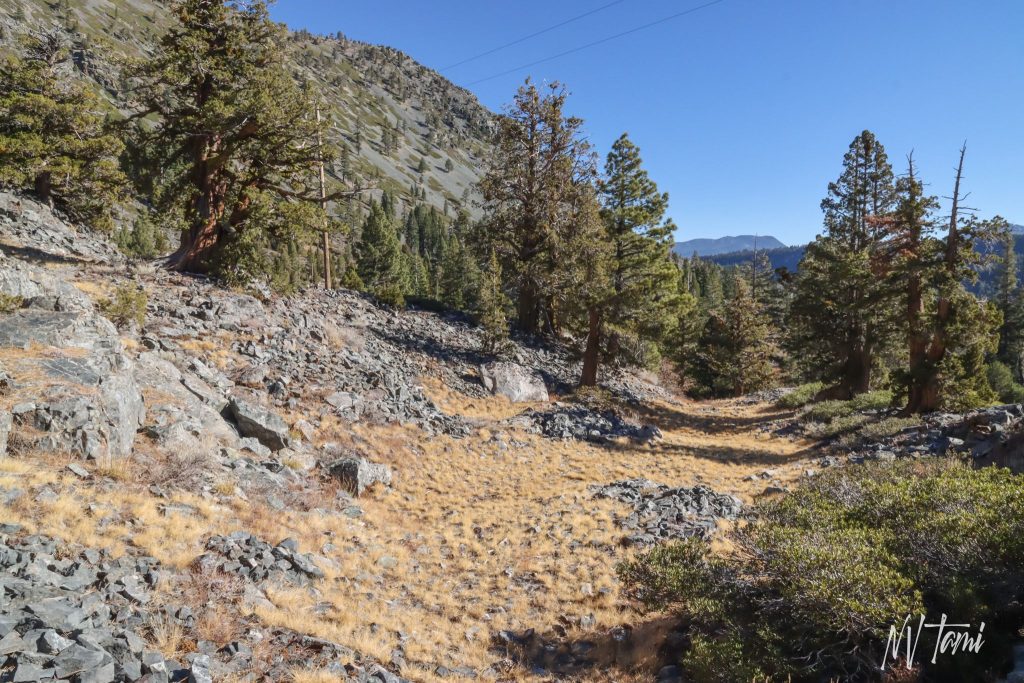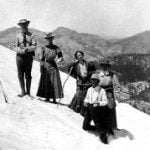
Having lived in the Tahoe area for twenty years, I thought I was familiar with most of the historical sites around the basin. When my friend and wildlife photographer, Dwayne Hicks, asked me to go on a hike, I was surprised when he told me we would be visiting a historic resort. Somehow I had never heard of the 150-year-old Glen Alpine Springs, the last resort of its era in the Tahoe Basin.

(Photo credit: Glen Alpine Springs)
When I think about gold rush, I imagine miners working their claims non-stop. They worked six days a week with only Sundays off for church and a popular game of baseball. In the gold fever craze, I didn’t think there was much time for play. I should have known people’s needs never change, and even 150 years ago they sought out recreation and relaxation. Hot springs and soda springs were popular as many believed in their restorative healing power.

(Photo credit: Tahoe Quarterly)
Beginning in the 1860s, resorts were scattered around Lake Tahoe. Most of them have been dismantled over the years or turned into residential or shopping areas. Only one remains, Glen Alpine Springs.

Nathan Gilmore and his brother Andrew emigrated from Ohio in 1850 to Hangtown, now known as Placerville. The brothers panned for gold, owned a general store and ranched. During summer, they herded their angora goats to Lake Tahoe for summer range. Nathan wed Amanda Gray in 1853 after “Not seeing the face of a good woman for three years”. In twenty-seven years of marriage the couple would have six children, but they lost several children under the age of five.

Nathan Gilmore: Developer and Original Lake Tahoe conservationist
(Photo credit: Calexploria)
Gilmore explored the Tahoe Basin and discovered Fallen Leaf Lake and the soda spring. Some speculate he discovered the springs while looking for pasture while others believe he maybe have been exploring Tahoe for health reasons after his baby Evelyn fell ill. He filed a deed in 1871 for 10,000 acres extending from Fallen Leaf to Mt. Tallac in Devil’s Valley Wilderness and the following year he filed for water rights.

Tent Camping at Glen Alpine Springs 1915
(Photo credit: Tahoe Quarterly)
Glen Apline Springs originally opened in 1873 as a “health resort” but became a popular place for recreation. Guests enjoyed nature hikes, bonfires and fishing in streams stocked with trout. Up to 120 guests at a time stayed in cabins or tents. Three meals a day were served using linen tablecloths, silver utensils and china dishware, all for the cost of $5 a day.
(Photo credit: Tahoe Culture)
It seems to me it’s one of the most delightful places in all the famous Tahoe region.
John Muir, 1892

Susie Jackson, famous Washoe basket maker taught basket weaving classes at the resort. c1899
(Photo credit: Glen Alpine Springs)
During the peak years in the early 1900s, the resort consisted of twenty five buildings, a two story sixteen room hotel, dining hall, kitchen, icehouse and a post office. Guests would arrive via horse-drawn stage after crossing Lake Tahoe, then known as Lake Biggler, by steamboat.

(Photo credit: Glen Alpine Springs)
Following a fire which destroyed many of the original structures, Bernard Maybeck was commissioned to design new buildings. Maybeck was one of the top 10 architects of all time in the US according to American Institute of Architecture. His design blended his signature arch style with native material including granite and “thatched” metal roofs. The buildings are considered some of the first fire-resistant structures at Lake Tahoe.

It’s a mile hike from the trailhead by Fallen Leaf Lake to Glen Alpine Springs. The trail follows the original wagon road. It is deceivingly easy at the beginning but quickly becomes rocky and steep. During the summer the hike can be hot. Remember to bring a hat and sunblock. We started our October hike at 8 am wearing down vests, gloves and wishing for hats. By mid morning it was perfect fall weather and we were in short sleeves. Remember you are hiking at 6800′ which can add extra challenges.

“Road” to the resort
Before the resort you pass several private cabins along with picture-perfect Lily Lake. In October the lake was frozen over in the morning but melted later in the day.
The trail leads past beautiful Modjeska Falls. The falls were named after famous Polish actress Helena Modjeska, who entertained resort guests in 1878. The falls run year around but are lower in autumn. I look forward to going back early summer to see them in their full glory.

Modjeska Falls
The first resort structure you find is the barn, built in 1889. The barn has a hay loft, tools and horse stalls.


The trails then splits. The left fork continues to the the soda springs and assembly hall. Depending on the time of the year, the spring water can saturate the area. A beautiful marsh and pond is to the side of the assembly hall. When we visited the colors were vibrant with fall and amazing ice formations blanketed the water.


The right fork leads to the dining hall, guest cabins and “Bubblestone Building”. The kitchen is original, but has been rebuilt and is fully functioning.



Bench outside of the Dining Hall. This bench must have some great stories to tell.

I noticed a strange building next to the cabins. I knew there had to be some significance to it and that I should take a few photographs. I was distracted by the dining hall and only ended up with the Bubblestone Cabin in the back of other structures. I was surprised when I researched later to find the cabin was the first use of lightweight concrete in the US.

Bubblestone Cabin: First of its kind
(Photo credit: Glen Alpine Springs)
Beyond the resort is the original hiking trails guests used 160 years ago. Trails lead into Desolation Wilderness and connects to the Tahoe Rim Trail.

Vacation style changed in the early 1900s. Instead of going to a remote resort and staying for a lengthy period, families opted for weekend trips they could access by private vehicle. Tourists flocked to the casinos and Squaw Valley, home of the 1960 Olympics. Glen Alpine Springs closed in 1966 after ninety-three years of operation. Hikers rediscovered the resort and it is now a popular hiking destination. They resort has been preserved and managed by a non-profit organization, Glen Alpine Springs.

Gilmore’s legacy reaches far beyond his resort. He is known as one of the first conservationists at Lake Tahoe. To prevent logging more trees at Lake Tahoe for the Comstock Mines, Gilmore transferred his claim to the Lake Tahoe Forest Preserve. Working with John Muir, the land became a forest preserve in 1899 and is now Desolation Wildness.

Enjoying the falls
Visited 10-29-2020
References
- Calexplornia: Glen Alpine Springs Resort Tahoe’s Earliest Resort is Filled with History and Adventure
- Glen Alpine Springs Organization: Glen Alpine Springs
- Tahoe Mountain Culture: Glen Alpine Springs “makes great lemonade!”
- Tahoe Quarterly: An Oasis of History High in the Hills















Andrew says
I’m quite pleased that I took time to check out your blog. Your report of Twaddle-Pedroli Ranch captured my attention . I just finished reading your Glen Alpine Springs article. I am looking forward to reading more. Thank you !
Tami says
Thank you for your sweet comment. I’m glad you are enjoying the history and my travels!